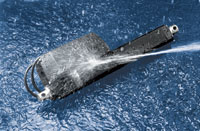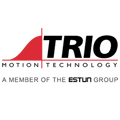
Posted to News on 25th Jun 2019, 00:00
Considerations for selecting electric actuators for harsh environments
Motion control technology can reduce the need for human exposure in harsh environments, while at the same time, enabling performance of operations beyond human capability. But mechanical components require protection too, and careful consideration of materials, coatings, sealing strategies, vibration and shock resistance, and maintainability can help system designers ensure they will get maximum performance and life out of the systems they intend to deploy in challenging environments.

As electromechanical actuators and other mechanical motion components expand in capability for heavy duty applications, so does their capability to resist harsh conditions. Extreme temperatures, high particulate levels, chemical exposure, high-pressure washdowns, vibration and shock, radiation, and electromagnetic interference are among the present threats to reliable motion control. System designers can mitigate these threats when selecting motion control components for such applications through careful evaluation of the following five design elements that contribute to robust operation: material selection, coatings, sealing strategy, vibration/shock resistance and maintainability.
Factor one – material selection: Material selection is the first line of defence against challenging environmental conditions. Material science is advancing steadily to create new alloys and hybrid materials that can withstand temperature extremes, exposure to chemicals or abrasive materials, frequent washdown, and other environmental forces. Stainless steel, hard-anodised aluminium and resistant polymers are among the most popularly deployed materials used to ruggedise motion control components.
Poor material selection will result in premature failures, expensive in-field service and repair, and lost productivity. Maximum protection comes when all motion control components – from the actuator housing to the smallest bearing – are selected with worst case operating scenarios in mind.
Factor two – coatings: Motion control components used in extremely corrosive environments, such as those characterised by exposure to hydrocarbons, urea and fertilisers, should also be coated with high-performance materials. This improves operation and reduces downtime, especially in environments where corrosive chemicals, salt spray or submersion will require additional protection. The right coating and material combination can extend component life 200-fold.
The most widely applied standard for chemical resistance is ISO 15003, which provides design requirements and guidance for the manufacturers of electrical and electronic equipment used in mobile agricultural machinery, forestry machinery, landscaping and gardening machinery. It provides test protocols for specific environmental conditions and defines severity levels for extreme environmental conditions that might occur during typical operations.
Factor three – sealing strategies: After materials and coatings, the next line of defence in harsh environments is the sealing strategy. Unless a component is adequately sealed, chemicals and particulates can make their way to internal component mechanisms, causing damage, build-up and clogging, and creating fertile ground for bacterial and other microbial growth. Deploying inadequately sealed motion control technology in harsh environments will require additional cost of enclosures and maintenance, and potentially more frequent maintenance.
Every component should be sealed, including motor mounts. Wipers, seals and gaskets are integral to success. The wiper brushes off contaminants from the extension tube during operation and prevents water intrusion. The seals back up the wipers to complete the protection. Gaskets provide sealing between housings, cover tubes, motors and rear mounting components.
One of the best indicators of a system’s sealing effectiveness is International Protection Marking, or IP Code. Its ingress protection (IP) rating is the global standard for measuring protection from the ingress of solid objects and liquids. The IP rating specifies the degree of environmental protection an enclosure provides against foreign materials that could impact performance.
The IP rating is composed of two numbers. The first number represents resistance to solids and the second to liquids. An IP rating of 00, for example, means there is no protection from solids or liquids. An IP rating of 11 means protection from ingress by objects larger than 50mm and from rain or condensation. An IP rating of 66 means protection from penetration by particulates the size of dust and from high-pressure water jets from any direction. This is considered the minimum for use in harsh environments today.
Factor four – vibration and shock resistance: Materials, coatings and sealing may be compromised by shock and vibration. Components must be tough enough to withstand the extremes of machines operating in harsh conditions. Often this translates into heavy loads or intense vibration or forces acting on the components, sometimes in near constant operation. The constant torque and movement can weaken a component over time and cause failure. By incorporating design features that account for high vibration or shock load, manufacturers eliminate the need for product accommodations.
Planetary gear designs provide more shock resistance than parallel gearing, and stiffness can be improved further by cutting one of the internal gears directly into the output housing. Leveraging a single-piece housing and ring gear, in this way, eliminates the chance of the gear slipping inside the housing, offering higher peak torque. Avoiding bushings with rolling elements can also help systems handle the constant stress environments as can depth/through case hardening of shafting. Proper mating of all components is also critical to shock protection.
Compliance with industry standards is one of the best ways to ensure that you get the shock protection you need. The three most common standards applied to motion control equipment are MIL- S -901, EN60068-2-27 and EN60068-2-32.
Factor five – maintainability: Harsh environments present risks to human safety from extreme temperatures, toxic/harsh chemicals or inhalation hazards – even radiation. Besides lost productivity and downtime, maintenance or replacement presents risk of injury or illness – especially if frequently done. Components that offer little to no maintenance improve employee safety and minimise potential for workplace accidents, while reducing costs.
Lubrication issues are one of the main maintenance drivers for linear motion components. Smooth, reliable motion is a hallmark of a well-designed system and this is ensured by maintaining the proper level of lubrication for moving components. Products that use oil for lubrication require routine maintenance and are predisposed to leaks. Components that pre-lubricate with grease or self-lubricate can greatly reduce or eliminate ongoing maintenance demands.
Motion control equipment manufacturer Thomson Industries offers a wide range of products designed for operation in harsh and hazardous environments. Its Max Jac heavy duty electric linear actuators, for example, are made of stainless steel, hard anodised aluminium or a highly resistant polymer. All seals are made of materials that withstand both organic and nonorganic chemicals and abrasive materials. They are designed to operate in a wide temperature range from -40 to plus 85°C. They are also rated for IP66/IP69K and have been tested for 500 hours of salt spray, withstand dirt, dust and water, and resist aggressive substances such as fertilisers, acid, oil, grease and cleaning agents.
Another addition to the Thomson electric linear actuator product line is the Electrak HD, which utilises stainless steel, e-coated zinc, and anodised aluminium materials to provide best-in-class protection in heavy duty environments. Further, the Electrak HD introduces advanced sealing features with the added benefit of IP66 dynamic protection to keep the internal components free of ingress – even while the actuator is operating. The internal components themselves are protected from drops, shocks, and interference from other electrical sources to ensure proper operation, regardless of external application demands.
Another product suitable for harsh environment operations is the Thomson PC Series precision linear actuators. The actuator, including the motor mount, is IP65 rated while its hardware design is made of stainless steel. This model proves to be stronger, faster and provides up to four times more travel distance in comparison with other actuators in the market.
The Thomson Movopart is a belt-driven, prism-guided linear system configuration with an optional washdown consideration. The prism guides are an engineered polymer that slide along the extrusion. These types of bearings are ideal for applications that have shock loads, need low noise, have a washdown or caustic environment. Additionally, its stainless-steel hardware and re-anodised machined aluminium parts make the system ideal for extreme environments.
The Thomson WH is a belt-driven, wheel-guided linear system where, just like the Movopart, you have an option for a washdown configuration. All hardware and guide elements are made of stainless steel and aluminium parts are re-anodized.
Thomson ball screws are applicable for a temperature range of -40 to +110°C. For use in very rough conditions Thomson customises the ball screws upon request by adding different, special-engineered wipers to the ball nuts which prevent the ingress of various types of dirt, i.e. from metal chips to fine dust. The Thomson Kokon comes with an impact-resistant elastomeric polymer PA12, covering the screw to fully protect it when using in very harsh, dirty applications.










